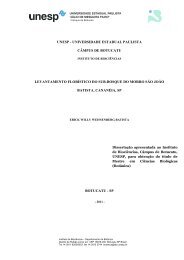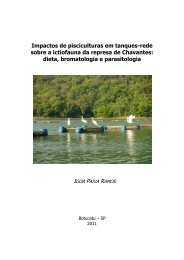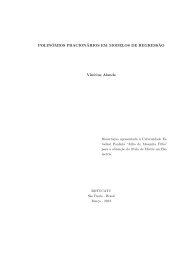Visualizar Tese - Instituto de Biociências - Unesp
Visualizar Tese - Instituto de Biociências - Unesp
Visualizar Tese - Instituto de Biociências - Unesp
You also want an ePaper? Increase the reach of your titles
YUMPU automatically turns print PDFs into web optimized ePapers that Google loves.
Andreo Fernando AguiarRESULTSBody weight and food intake. Throughout the experiment, the body weightevolution of the groups and the final average body weight are shown in Fig. 3 and Table2, respectively. Confirming that animals initiated the experiment with similar healthstatus, no significant (p > 0.05) difference was observed in the initial body weightamong the groups (Table 2). After 8 and 12 weeks of experiment, all groups showedsignificant (p < 0.05) body weight gain (∆%) (Fig. 3 and Table 2); the values were21.7%, 26.2%, 30.8% and 33.5% in the T8, C8, T12 and C12 groups, respectively(Table 2). These values were not statistically (p > 0.05) different among all groups.Table 2. Initial and final body weight, and body weight gain (∆%) inexperimental groups.Groups Initial body weight (g) Final body weight (g) %T8 336.3 ± 28.6 429.6 ± 49.9* 21.7C8 308.9 ± 27.1 418.6 ± 37.7* 26.2T12 326.0 ± 27.8 471.4 ± 34.9* 30.8C12 302.8 ± 32.3 455.1 ± 61.8* 33.5Values are means ± SD. n= 8 rats per group. C8, 8 weeks control; T8, 8weeks trained; C12, 12 weeks control; and T12, 12 weeks trained. *Significant difference compared to their initial body weight at p< 0.05.The similar progression of PC in both trained and control groups <strong>de</strong>monstratedthat the training mo<strong>de</strong>l used, although intense, did not subject the animals to state ofovertraining. The data show that the increase in body weight reflected only the somaticgrowth of animals, given that they began the experiment in the young phase. Consistentwith no significant (p > 0.05) change in body weight, resistance training did notpromote significant (p > 0.05) alteration in food intake in the T8 and T12 groupscompared to the C8 and C12 groups, respectively (Figure x).53
















